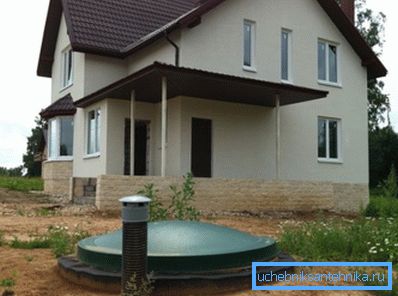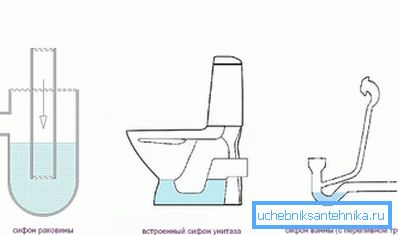Local sewage: ways to its successful implementation
Arrangement of local sewage at the dacha - is one of the primary needs, standing on a par with the supply of electricity and drilling a well. After all, human waste does not disappear by itself, and the connection of a common central system outside the city is usually not possible.
Next, we look at solutions to this problem and related recommendations.

General provisions
What is generally meant by the local sewer system? Let's figure it out:
| Part of the system | Purpose |
| Reservoir | It is this element that replaces with itself and makes it unnecessary to connect to the central sewage system, since it is designed to collect and in some cases filter sewage |
| Main external highway | A wide pipe passes from the tank to the house, through which the waste liquid flows. |
| Internal piping | All plumbing in the building is connected by pipes and is connected to the external highway |
| Ventilation | Ensures the movement of air masses inside the structure |

Features of the selection and installation of the main element
The device of the local sewage system in a private house begins, as indicated and in the table, from the tank for drains. This is the most important part of the entire system, so we will pay the most attention to it.
To date, there are several suitable options allowing for the collection of sewage, divided by their functionality into two groups:
| Group name | Functions | Representatives |
| Accumulation facilities | Collect sewage for the purpose of their subsequent removal with the help of vacuum trucks | Cesspools, manholes and single chamber septic tanks |
| Treatment plant | Not only collect, but also recycle sewage, which reduces the frequency of calls of vacuum trucks, or makes it unnecessary | Multi-chamber septic tanks and forced cleaning stations |
Further your attention is given a more detailed description of the most frequently used structures.
Cesspools
Here it is worth noting immediately the three options for its arrangement:
- Untight. It is a trench dug to a depth of at least two and a half meters without subsequent waterproofing, with partial strengthening of earthen walls with boards or other improvised materials. The selling price of such a structure, respectively, is the lowest in comparison with other analogues.
But before rejoicing at the opportunity to save money, consider its disadvantages:
- Low productivity, usually not exceeding one cubic meter of waste per day.
- An unpleasant smell spreading around, leaking through the soil.
- Contamination of the soil, which will make it unsuitable for use for many years even after the destruction of the pit itself.
- The possibility of penetration of rain and melt water, causing overflow of the reservoir.
- Restrictions on placement: no closer than five meters from a residential building, two from the fence and twenty-five from the well or well.
Advice: it is recommended to stop at the creation of an untight cesspool at only rarely visited summer houses. Otherwise, the problems with it will be much more than the benefits.

- Partially sealed or sewer well. In this case, the creation of waterproof walls is envisaged, which significantly reduces the flow of sewage into the ground, but still does not exclude it.
Tip: Cover the bottom with a thick layer of gravel. The liquid absorbed through it will undergo partial filtration and harm the environment less.

- Airtight. Fully insulated structure, which is already rather a single-chamber septic tank, is more expensive to implement and needs frequent cleaning, but it eliminates the spread of fetid odors and does not harm the soil.

Sewage treatment plant
- Septic tanks with one or three cameras. Although they are by themselves and more expensive than ordinary holes, they are much cheaper to operate.
The instruction of their work is as follows:
- In the first compartment, heavy insoluble fractions are deposited under the action of bioactive additives.
- In the next, the liquid is filtered, after which it either goes into the third compartment of a deeper cleaning or goes down into the soil.

- Cleaning stations. They are expensive and constantly in need of electricity equipment, which, on the other hand, completely eliminates the need to call a vacuum truck, discharging purified water at the outlet.

Features of mounting the remaining elements of the system
After you have decided on the stock collector and installed it, move on:
- We connect a plastic pipe with a diameter of 110 mm to the septic tank.
- Paving it from the drive to the house at a depth below the freezing of the soil, while observing a slight bias towards the treatment plant. We warm the highway with polyurethane foam or mineral wool.

- Next, we carry out the internal pipeline, using also PVC pipes of only smaller diameter.
- At each plumbing install hydraulic lock to prevent the penetration of unpleasant odors in the house.

- We install a ventilating sewer pipe in order to exclude the exhaustion of the air in the system, due to which water in the hydraulic locks is lost.
Conclusion
Autonomous sewage solves all the problems associated with waste of our life. The main step in arranging it is the selection and installation of a suitable sewage collector. Above, we have reviewed the most common options and provided recommendations for installation work.

The video in this article will provide you with additional information. Take care of the conditions of life in your country house properly.